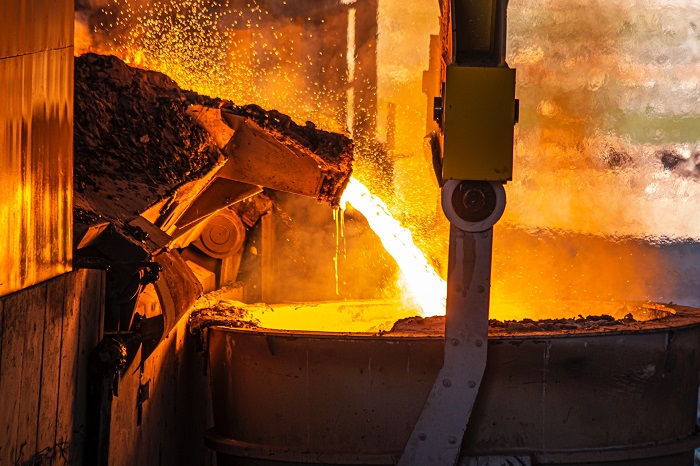ISABEL RUBIO ARROYO | Tungsteno
Every year, more than 450 million tonnes of construction and demolition waste is generated in the European Union, 75% of which ends up in landfills. Recycling the materials used to build the majority of the world's buildings is not only an effective way to reduce the impact on the environment, but is also a means to reduce costs. We analyse the most commonly used materials according to their reusability.
Steel
Steel is an indispensable material in all types of infrastructure, from houses and skyscrapers like the Burj Khalifa to bridges like the Golden Gate and oil platforms. What makes this material so special is that it is 100% recyclable. All scrap can be recycled over and over again to create more steel. This new material "maintains the inherent properties of the original steel and the quality can also be improved on recycling," according to the World Steel Association. "Today's steel products will become tomorrow's cans, trains, bridges or buildings." A steel beam can be recycled into exactly the same beam, or a car body or a pavement railing, as steel products specialist company Ferros Planes explains.
On average, new steel products contain approximately 37% recycled steel. In the recycling process, magnets are used to separate the materials. "The greater the inherent magnetism of a metal, the more of it and the more often it can be recycled and the better it retains its properties," explain Ferros Planes. However, it is not always easy to give this alloy a second life. While carbon steels and other alloys with magnetic properties are the most recyclable, the characteristics of some stainless steels make their reuse difficult.
In theory, if this material continues to be produced, it is because there is not enough scrap metal available to meet demand. Many steel constructions are designed to last for decades or even centuries. Even so, steel is the most recycled building material in the world, according to the UK-based Galvanisers Association. Only 1% of all steel manufactured is lost to landfill or rust. Reusing it not only provides an energy savings of 70%, but also reduces the consumption of virgin resources. For example, recycling one tonne of steel scrap can save 1,400 kilograms of iron, 740 kilograms of coal and 120 kilograms of limestone.

New steel products contain about 37% recycled steel. Credit: Unsplash.
Glass
Most glass waste is produced by demolition projects of structures or the replacement of windows or doors in refurbishment projects in buildings. Although building glass is a 100% recyclable material, it is almost never recycled at the end of its useful life into new glass products, according to the European association Glass for Europe. Instead, it is often crushed alongside other building materials and deposited in landfills. But giving glass a second life comes with some complications: its extraction, recovery and transport to collection centres can be costly. In addition, plate glass may be broken and contaminated by other building materials, which complicates its efficient recycling.
Reducing the amount of glass waste going to landfill is therefore a major environmental challenge. Research published in the journal Construction and Building Materials indicates that transforming glass back into a building material reduces the consumption of natural resources and minimises greenhouse gas emissions.
Today, although it is not a widespread practice, recycled glass is used to make flooring, paving and decorative products. Across the EU, recycling could prevent 925,000 tonnes of glass waste from construction from ending up in landfills, according to a report by engineering firm Arup. It could also save 1.23 million tonnes of primary raw materials and reduce carbon emissions by more than 230,000 tonnes a year.

Extracting, recovering and transporting glass to collection centres can be costly. Credit: Unsplash.
Concrete
Concrete, present in structures such as the Pantheon in Rome, is the most widely used building material in the world. However, because of its manufacture, it has a huge environmental impact; the processes used to produce the cement from which concrete is then created generate large carbon dioxide emissions. More than four billion tonnes of cement are produced each year, accounting for around 8% of global CO2 emissions, according to the report Making Concrete Change.
For decades, researchers around the world have been looking for ways to recycle concrete. After the demolition of a building, it is possible to crush this material in special machines and then sort the fragments by size. The most efficient recycling method would be to do the crushing on site, which reduces construction costs and the air pollution generated by transporting the material elsewhere. Some concrete may contain contaminants such as pigments, calcium sulphate, chlorides and oils. In this case, it may be advisable to avoid using it as raw material to avoid any potential problems.
Approximately 60% of the crushed material can be recycled. These fragments can be used, for example, as base materials for creating asphalt and roads. The aggregate could also be used to replace gravel in concrete, an important factor considering the ecological and socio-economic impact of the billions of tonnes of sand and gravel extracted annually to feed the global concrete industry. While it is possible to use this recycled concrete aggregate to create new concrete structures, doing so requires the addition of more cement, sand and water to ensure adequate durability.

Recycled concrete fragments serve as base materials for creating asphalt and roads. Credit: Unsplash.
Reducing the amount of building materials that are disposed of in landfills or incinerated is key to achieving a circular economy. Pursuing this ambitious goal can, in addition to creating jobs in the recycling industry, offset the environmental impact associated with the extraction and consumption of virgin resources and the production of new materials. As highlighted by the US Environmental Protection Agency, it also serves to reduce the costs and carbon footprint associated with transporting these products. Giving steel, glass and concrete—and other materials such as wood, plaster or plastic—a second life is essential in the move towards more sustainable construction.
· — —
Tungsteno is a journalism laboratory to scan the essence of innovation. Devised by Materia Publicaciones Científicas for Sacyr’s blog.
